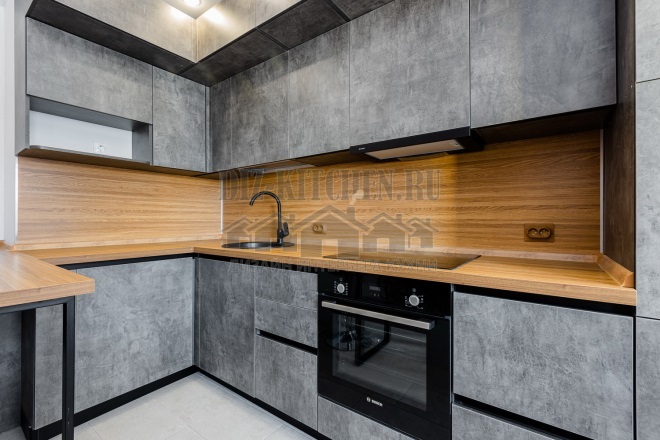During renovation work, many property owners are trying to find an answer to the question: what is the best ceiling in the kitchen? First of all, you need to pay attention to the harmony of all elements of the room. In the kitchen, the ceiling must be matched with the flooring and wall material. In this room, high humidity, traces of grease and dirt can remain on the enclosing structures. Care must be taken to select the materials for the coating. Such products must be well cleaned of dirt, resistant to moisture and sudden temperature fluctuations.

Nuances of material selection
On the modern market, you can find a huge number of products that can be used to decorate the kitchen ceiling. These include:
Attention! Earned on our website kitchen designer. You can familiarize yourself with it and design your dream kitchen for free! May also come in handy wardrobes designer.
- rack-and-pinion structures;
- tension;
- decorative panels.
In addition to these options, the surface can be painted or wallpaper. The most budgetary option is a thorough leveling of the base and subsequent painting. In this case, an environmentally friendly plaster and putty are used. In the future, whitewash or water-based paint is applied to the leveled base. This decoration option allows you to visually expand the usable space, which is considered a significant plus for small kitchens.
The disadvantage of plastering the surface is the laboriousness of the process. To obtain a perfectly even and smooth base, it is necessary not only to apply the solution, but also to clean the surface, and this takes a lot of time. There are other methods for arranging the ceiling.
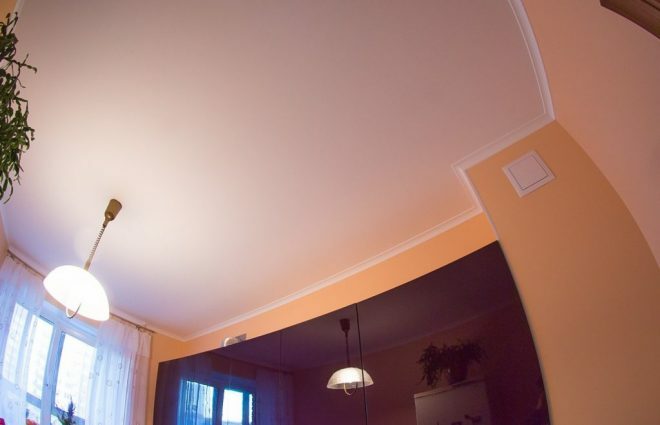
The main methods of installing the ceiling
To obtain a high-quality and reliable ceiling in the kitchen, you can use the following materials:
- metal profile and plasterboard sheets;
- decorative plastic panels;
- polyvinyl chloride film or fabric for false ceilings;
- paint of the desired color;
- wallpaper;
- special tiles.
When choosing any of the suitable materials, study its technical characteristics, strengths and weaknesses. Pay attention to the resistance of the products to moisture and sudden changes in temperature. Let's consider all the existing options.
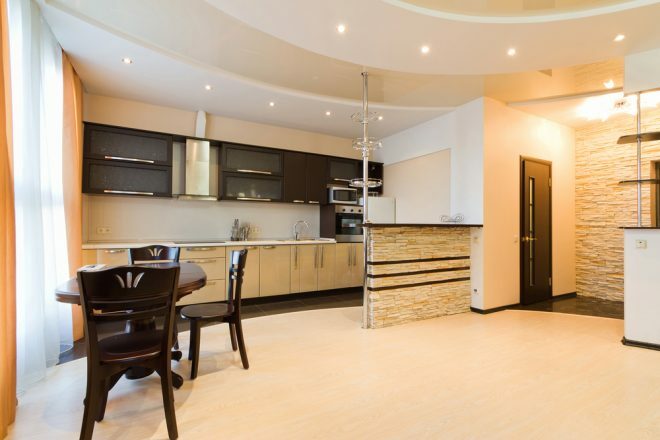
Drywall
One-level and multi-level plasterboard ceilings have become especially popular among users. This material with a perfectly flat surface allows you to hide all defects in the base. Under a multi-level structure, you can successfully disguise the wiring or hide engineering communications. There are a huge number of design decisions regarding the shape of the ceiling. LED lamps can be inserted into drywall sheets. Such lighting elements not only look beautiful, but also allow you to divide the room into several functional areas.
If the user decides to choose multi-level structures for the manufacture of a ceiling, then he must carefully study the technical characteristics of drywall. For operation in this room, it is advisable to select moisture-resistant products. Such materials do not change their linear dimensions and original shape after exposure to moisture, they are well cleaned of contamination. It is advisable to use multi-level structures in high rooms.

Plastic decorative panels
This finish is recommended for rooms with insufficient ventilation. Such products do not need special care, their surface is well cleaned of dirt using standard detergents. The installation of PVC panels can be performed even by an inexperienced builder. Plastic decorative panels are the best option for beginner craftsmen.
The products in question enter the construction market in various colors, which allows you to select the material for a specific, already existing style of room. In tall rooms, you can make a beautiful structure, which consists of several levels. Each of the tiers is performed with a gap of 7-10 centimeters.
When finishing the surface with decorative PVC panels, choose products that do not deform as a result of sudden temperature changes. Such materials must have quality certificates that state that the product does not emit toxic substances during exposure to high temperatures.
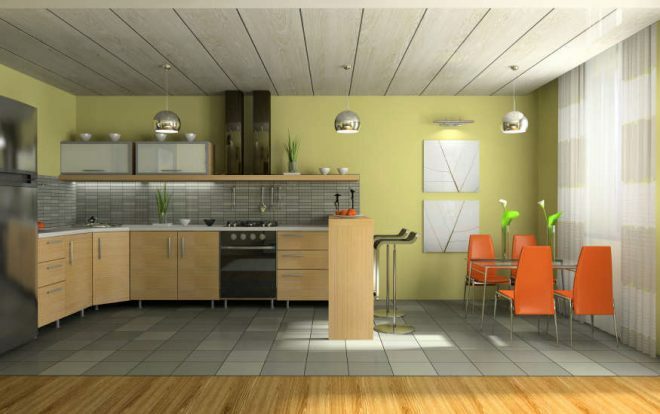
Surface painting
Going through various options for the ceiling in the kitchen, many users give preference to painting the surface, because everyone can do this work without the slightest skill. For the kitchen, it is better to select environmentally friendly washable dyes. The workflow takes place in the following sequence:
- We align the base, clean it from dirt and dust.
- Cracks and irregularities on the surface are repaired with a putty.
- Let the solution dry, take fine-grain sandpaper and rub all the irregularities on the base.
- Apply a deep penetration primer using a paint brush or roller. When the solution is dry, we repeat the operation again.
- We carry out staining. At the points of contact with the walls, we go through with a brush, on the rest of the surface, the paint is applied with a roller.
In some cases, yellow spots may appear on the coating. To prevent this from happening, an alkyd dye is applied to the defective areas.
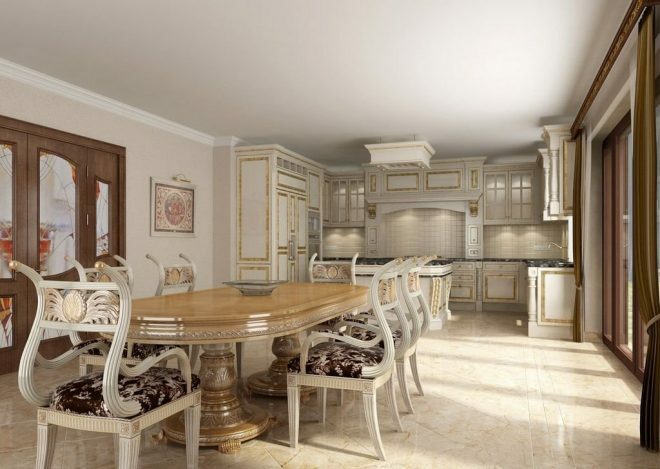
Using ceiling tiles
Many users do not know what kind of ceiling to make in the kitchen with their own hands. Ceiling tiles are considered one of the simplest materials. To lay such products, no special skills are needed; the work is carried out using a simple construction tool. To finish the ceiling, you must have on hand:
- a sufficient number of expanded polystyrene tiles;
- glue;
- construction tape;
- stationery knife with replaceable blades;
- notched trowel.
The tile allows you to hide cracks and small irregularities in the base, but with significant differences in height, the surface must be leveled with plaster. When laying the material with a notched trowel, smear the glue, then press the tile tightly.
It is advisable to use products with a laminated surface, they are better cleaned of dirt. If it is impossible to remove the stains, then individual parts are replaced with new ones or the ceiling is painted. Ceilings are tiled in small kitchens with good ventilation. To prevent possible deformations, the lighting fixtures are placed at a distance of 20 centimeters from the coating.
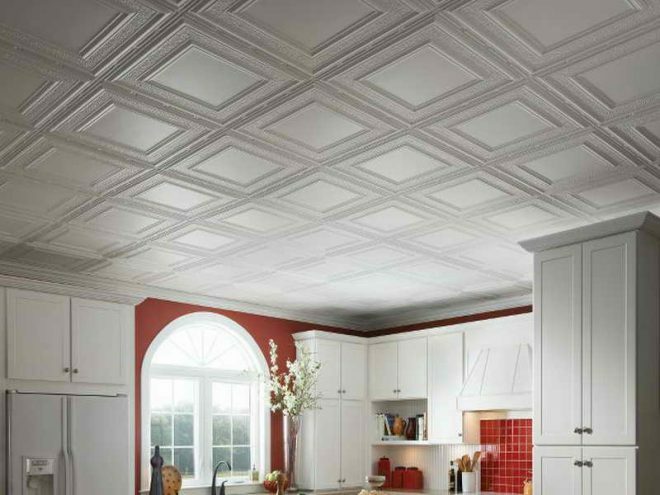
Wallpapering
This method of decorative ceiling decoration has a number of advantages over other options:
- low material cost;
- the ability to mask small cracks and elevation differences on the base;
- moisture resistance of the coating, easy and quick cleaning of the surface from all kinds of dirt;
- up to 10 layers of paint can be applied to high-quality wallpaper, which allows you to often refresh the interior and bring to life the most daring design ideas;
- a huge selection of textures, patterns and colors of roll materials;
- high speed of work.
Each property owner can make his kitchen space cozy, the main thing is to develop a ceiling design in advance. Pay special attention to the type of glue, because each composition is selected for a specific wallpaper. With the wrong choice of solution, the quality of the pasting deteriorates.

Stretch ceiling
Fabric or film stretch ceilings are especially popular. This beautiful coating can be installed quickly, but it requires certain skills and special tools. The advantages of stretch ceilings include:
- the ability to mask unevenness and other defects on the base surface;
- lack of preparatory work, the film is stretched over a special frame on an unprepared base;
- allows you to hide various engineering communications;
- the coating does not need special care;
- the film does not allow moisture to pass through;
- stretch ceiling has a long period of operation;
- the ability to choose a huge number of colors and shades, the option using a photo;
The dense and durable material retains water, which prevents flooding from the neighbors upstairs.
Do you know what a kitchen apron is?
Kitchen cabinet facades
9.78%
Apron hanging on a hook next to the sink
15.11%
Wall between the bottom edge of the wall cabinets and the worktop
75.11%
Voted: 225
average rating 1 / 5. Number of ratings: 1
No ratings yet. Be the first to rate.

